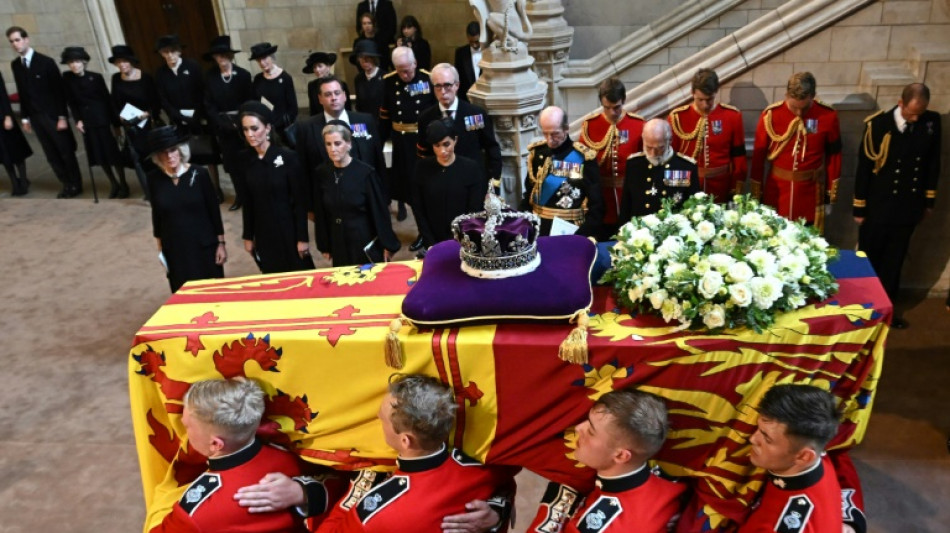
RBGPF
-0.5000


Here is a timeline of Queen Elizabeth II's death, including her final days and the aftermath of her passing aged 96, after more than 70 years on the throne.
- September 6 -
The queen receives Boris Johnson at her Balmoral private retreat in the Scottish Highlands, to accept his resignation as prime minister.
Shortly afterwards, she receives Liz Truss, the new leader of Britain's governing Conservative Party, and invites her to form a government as prime minister.
- September 7 -
Her final public statement, as queen of Canada, is a message of condolence for victims of the Saskatchewan stabbings.
"I mourn with all Canadians at this tragic time," it ends.
The queen pulls out of an online meeting of the Privy Council formal body of advisers, during which Truss would have taken an oath and her new cabinet ministers formally sworn in.
"After a full day yesterday, Her Majesty has this afternoon accepted doctors' advice to rest," Buckingham Palace says.
- September 8 -
Prince Charles flies to Balmoral, arriving at 10:30 am (0930 GMT).
Buckingham Palace issues a statement at 12:30 pm saying that doctors were concerned for her health and recommended she remain under medical supervision.
"The queen remains comfortable and at Balmoral," it says.
Truss is informed of her death at 4:30 pm.
Her death is announced publicly at 6:30 pm.
"The Queen died peacefully at Balmoral this afternoon," the statement says.
Her daughter Princess Anne was with her during her last 24 hours.
Upon her death, her eldest son immediately becomes King Charles III.
- September 9 -
King Charles III and his wife Camilla, the Queen Consort, travel from Balmoral to Buckingham Palace in London where they greet mourners outside the gates.
The king meets Truss then pays tribute to his mother in a televised broadcast.
He renews her promise of lifelong service and pledges to uphold Britain's constitutional principles.
He makes his eldest son Prince William the Prince of Wales.
A prayer service at London's St. Paul's Cathedral is attended by senior politicians. The ceremony sees the first official singing of "God Save The King" since 1952.
- September 10 -
King Charles III is formally proclaimed as the new monarch in a ceremony in London.
Twenty-one gun salutes are fired around the country.
In a rare show of unity, the king's sons, princes William and Harry, and their respective wives Catherine and Meghan, view the floral tributes outside Windsor Castle.
- September 11 -
Queen Elizabeth II's coffin is driven from Balmoral to the Palace of Holyroodhouse in Edinburgh, the monarch's official residence in Scotland. Anne accompanies the cortege.
- September 12 -
King Charles III addresses both houses of parliament in Westminster Hall in London.
The king and queen consort fly to Edinburgh.
A procession takes Queen Elizabeth II's coffin to St Giles' Cathedral. Her four children march behind the hearse.
Members of the royal family attend a service celebrating her life.
King Charles III addresses the Scottish Parliament.
The first of 33,000 mourners file past the coffin in the cathedral.
For around 10 minutes, Queen Elizabeth II's children mount the guard around her casket.
- September 13 -
The king and queen consort fly to Belfast.
The king meets Northern Irish lawmakers and delivers a speech. He shakes hands with Irish President Michael D. Higgins at a service at St. Anne's Cathedral -- the first foreign head of state to meet the new king.
Charles III returns to London.
Queen Elizabeth II's coffin, accompanied by Anne, is flown from Edinburgh to London on a military transport plane. It is then driven to Buckingham Palace.
- September 14 -
The coffin is taken on a gun carriage from Buckingham Palace to Westminster Hall to lie in state. Tens, if not hundreds of thousands of people, are expected to pay their last respects by filing past her coffin.
M.T.Smith--TFWP